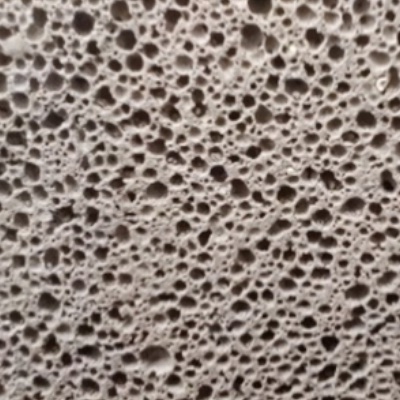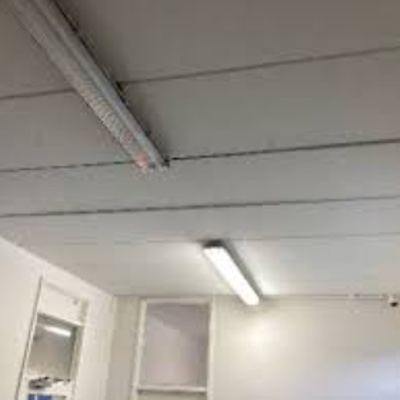Estates is definitely front and centre of every school’s focus currently, but sadly for all the wrong reasons. RAAC (or reinforced autoclaved aerated concrete to give it its full title) has been hitting the headlines for some months now but what exactly is it and what’s the problem with it? More importantly, what action do you need to take whether you think you’ve got RAAC in your school or not?
What is RAAC?
RAAC is a lightweight, ‘bubbly’ form of concrete that was commonly used in construction between the 1950s and the mid-1990s. The Youtube link below shows the difference between RAAC and traditional concrete.
Where is RAAC found?
RACC is predominantly found as precast panels in roofs (commonly flat roofs but sometimes pitched roofs as well), and occasionally it is found in floors and walls.
What does RAAC look like?
The photos below show what RAAC looks like, both in close-up view and on a ceiling


How can I find out if my school has RAAC?
- Identify which of your buildings were built or refurbished between 1950 and the mid-1990s.
- Check any original designs and drawings and look for any mention of “RAAC” or “Reinforced autoclaved aerated concrete”. Common manufacturers of RAAC panels were Siporex, Durox, Celcon, Hebel and Ytong.
- Also check any building condition surveys that have been carried out.
- Carry out a visual inspection of your buildings. Bear in mind that RAAC may be concealed above suspended ceilings. (Before removing suspended ceiling tiles, be sure to check your asbestos management survey first to find out if there is asbestos in that area. If there is, do not disturb it).
- Look for panels that are typically 600mm wide and 2.4m long with V-shaped grooves. RAAC panels may bow or deflect so that you can see a ‘gap’ between 2 panels.
- Check the texture of the panels. RAAC panels are slightly crumbly when touched and easy to gouge with a screwdriver. However, if the concrete has been heavily coated or painted, it may be harder to identify if it is RAAC or not.
- Check the sound of the panels. When tapped gently with a lump hammer, RAAC panels will sound hollow as opposed to traditional concrete that makes a dull ‘thud’ sound.
- Take photos of any suspected RAAC so that you can expand them on a computer to get a close-up view.
What action do I need to take if I think my school has RAAC?
Unless you have found documentary evidence that your school has RAAC, the only way to be sure is for your school to be inspected by a structural engineer. If you suspect that your school has RAAC, you need to inform the Department for Education urgently by completing the RAAC questionnaire on the DfE Capital Portal which can be accessed via https://dfe-capital2.microsoftcrmportals.com
When completing the survey, you should answer “Yes” to Question 2.3 Did the investigation identify RAAC panels being present?
If you don’t have a Capital Portal account, you can request one via this link: https://forms.office.com/Pages/ResponsePage.aspx?id=yXfS-grGoU2187O4s0qC-RgqHYnAYa9Phav9PaPyga1UOEJKOEZIQTVJNU9YTlFWU1pQOTNKTDBVTC4u
What action do I need to take if I don’t think my school has RAAC?
You still need to let the Department for Education know as a matter of urgency by completing the RAAC questionnaire (see weblinks above) so that the Department have the most up-to-date and accurate information.
What is the DfE doing to help schools?
The DfE’s Complex Projects Team assists schools with serious building issues. The Team normally consists of 8 members of staff, but this has been increased to 80 staff over the last 10 days, enabling any school with RAAC or suspected RAAC to be allocated a member of staff to assist them. For every school that indicated in their RAAC questionnaire that they suspected they had RAAC, the DfE has instructed a structural engineer or building surveyor to visit the school to inspect. Three of the firms that the DfE has been using for CDC2 school visits have now been instructed to focus on RAAC inspections, and an additional 5 firms have been appointed by the DfE. The DfE’s aim is that all schools who have indicated they have identified or suspect that they have RAAC in their questionnaires will have been instructed to be visited by the end of September.
And finally …
Schools should always:
- Refer to suitably qualified professionals for detailed advice and guidance.
- Read the latest government advice – see the Department for Education’s Reinforced Autoclaved Aerated Concrete (RAAC): Identification guidance (updated September 2023) which can be accessed via

Register Now
Join The Trust Network FREE
